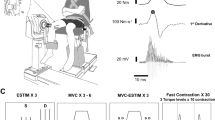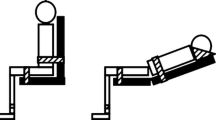Abstract
While it is often reported that muscular coactivation increases with age, the mechanical impact of antagonist muscles, i.e., the antagonist torque, remains to be assessed. The aim of this study was to determine if the mechanical impact of the antagonist muscles may contribute to the age-related decline in the resultant torque during maximal voluntary contraction in knee flexion (KF) and knee extension (KE). Eight young (19–28 years old) and eight older (62–81 years old) healthy males participated in neuromuscular testing. Maximal resultant torque was simultaneously recorded with the electromyographic activity of quadriceps and hamstring muscles. The torque recorded in the antagonist muscles was estimated using a biofeedback technique. Resultant torques significantly decreased with age in both KF (−41 %, p < 0.005) and KE (−35 %, p < 0.01). Agonist and antagonist torques were significantly reduced in KF (−44 %, p < 0.05; −57 %, p < 0.05) and in KE (−37 %, p < 0.01; −50 %, p < 0.05). The torque elicited by double twitch stimulation (−37 %, p < 0.01) and the activation level (−12 %, p < 0.05) of quadriceps was significantly lower in older men compared to young men. This study showed that antagonist torques were not responsible for age-related declines in KF and KE resultant torques. Therefore, decreased resultant torques with age, in particular in KE, can primarily be explained by impairments of the peripheral factors (excitation–contraction coupling) as well as by decreased neural agonist activation.




Similar content being viewed by others
References
Aalbersberg S, Kingma I, Blankevoort L, van Dieen JH (2005) Co-contraction during static and dynamic knee extensions in ACL deficient subjects. J Electromyogr Kinesiol 15:349–357
Allen GM, Gandevia SC, McKenzie DK (1995) Reliability of measurements of muscle strength and voluntary activation using twitch interpolation. Muscle Nerve 18:593–600
Aniansson A, Hedberg M, Henning GB, Grimby G (1986) Muscle morphology, enzymatic activity, and muscle strength in elderly men: a follow-up study. Muscle Nerve 9:585–591
Aniansson A, Grimby G, Hedberg M (1992) Compensatory muscle fiber hypertrophy in elderly men. J Appl Physiol 73:812–816
Baratta R, Solomonow M, Zhou BH, Letson D, Chuinard R, D’Ambrosia R (1988) Muscular coactivation. The role of the antagonist musculature in maintaining knee stability. Am J Sports Med 16:113–122
Behm DG, Sale DG (1996) Influence of velocity on agonist and antagonist activation in concentric dorsiflexion muscle actions. Can J Appl Physiol 21:403–416
Behm DG, St-Pierre DM, Perez D (1996) Muscle inactivation: assessment of interpolated twitch technique. J Appl Physiol 81:2267–2273
Billot M, Simoneau E, Van Hoecke J, Martin A (2010) Coactivation at the ankle joint is not sufficient to estimate agonist and antagonist mechanical contribution. Muscle Nerve 41:511–518
Billot M, Simoneau EM, Ballay Y, Van Hoecke J, Martin A (2011) How the ankle joint angle alters the antagonist and agonist torques during maximal efforts in dorsi- and plantar flexion. Scand J Med Sci Sports 21:e273–e281
Bilodeau M, Erb MD, Nichols JM, Joiner KL, Weeks JB (2001) Fatigue of elbow flexor muscles in younger and older adults. Muscle Nerve 24:98–106
Carolan B, Cafarelli E (1992) Adaptations in coactivation after isometric resistance training. J Appl Physiol 73:911–917
Clark DJ, Fielding RA (2012) Neuromuscular contributions to age-related weakness. J Gerontol A Biol Sci Med Sci 67:41–47
Clark BC, Taylor JL (2011) Age-related changes in motor cortical properties and voluntary activation of skeletal muscle. Curr Aging Sci 4:192–199
Colson S, Pousson M, Martin A, Van Hoecke J (1999) Isokinetic elbow flexion and coactivation following eccentric training. J Electromyogr Kinesiol 9:13–20
Crone C, Nielsen J (1994) Central control of disynaptic reciprocal inhibition in humans. Acta Physiol Scand 152:351–363
de Boer MD, Morse CI, Thom JM, de Haan A, Narici MV (2007) Changes in antagonist muscles’ coactivation in response to strength training in older women. J Gerontol A Biol Sci Med Sci 62:1022–1027
De Luca CJ, Mambrito B (1987) Voluntary control of motor units in human antagonist muscles: coactivation and reciprocal activation. J Neurophysiol 58:525–542
De Serres SJ, Enoka RM (1998) Older adults can maximally activate the biceps brachii muscle by voluntary command. J Appl Physiol 84:284–291
Doherty TJ (2003) Invited review: aging and sarcopenia. J Appl Physiol 95:1717–1727
Frontera WR, Hughes VA, Lutz KJ, Evans WJ (1991) A cross-sectional study of muscle strength and mass in 45- to 78-yr-old men and women. J Appl Physiol 71:644–650
Frontera WR, Hughes VA, Fielding RA, Fiatarone MA, Evans WJ, Roubenoff R (2000) Aging of skeletal muscle: a 12-yr longitudinal study. J Appl Physiol 88:1321–1326
Greig CA, Young A, Skelton DA, Pippet E, Butler FM, Mahmud SM (1994) Exercise studies with elderly volunteers. Age Ageing 23:185–189
Hakkinen K, Kallinen M, Izquierdo M, Jokelainen K, Lassila H, Malkia E, Kraemer WJ, Newton RU, Alen M (1998) Changes in agonist–antagonist EMG, muscle CSA, and force during strength training in middle-aged and older people. J Appl Physiol 84:1341–1349
Hortobagyi T, Devita P (2006) Mechanisms responsible for the age-associated increase in coactivation of antagonist muscles. Exerc Sport Sci Rev 34:29–35
Hortobagyi T, Tunnel D, Moody J, Beam S, DeVita P (2001) Low- or high-intensity strength training partially restores impaired quadriceps force accuracy and steadiness in aged adults. J Gerontol A Biol Sci Med Sci 56:B38–B47
Hunter SK, Thompson MW, Adams RD (2000) Relationships among age-associated strength changes and physical activity level, limb dominance, and muscle group in women. J Gerontol A Biol Sci Med Sci 55:B264–B273
Izquierdo M, Ibanez J, Gorostiaga E, Garrues M, Zuniga A, Anton A, Larrion JL, Hakkinen K (1999) Maximal strength and power characteristics in isometric and dynamic actions of the upper and lower extremities in middle-aged and older men. Acta Physiol Scand 167:57–68
Jakobi JM, Rice CL (2002) Voluntary muscle activation varies with age and muscle group. J Appl Physiol 93:457–462
Kellis E (1998) Quantification of quadriceps and hamstring antagonist activity. Sports Med 25:37–62
Kellis E, Katis A (2008) Hamstring antagonist moment estimation using clinically applicable models: muscle dependency and synergy effects. J Electromyogr Kinesiol 18:144–153
Kent-Braun JA, Ng AV (1999) Specific strength and voluntary muscle activation in young and elderly women and men. J Appl Physiol 87:22–29
Klass M, Baudry S, Duchateau J (2007) Voluntary activation during maximal contraction with advancing age: a brief review. Eur J Appl Physiol 100:543–551
Klein CS, Brooks D, Richardson D, McIlroy WE, Bayley MT (2010) Voluntary activation failure contributes more to plantar flexor weakness than antagonist coactivation and muscle atrophy in chronic stroke survivors. J Appl Physiol 109:1337–1346
Krishnan C, Williams GN (2009) Sex differences in quadriceps and hamstrings EMG–moment relationships. Med Sci Sports Exerc 41:1652–1660
Krishnan C, Williams GN (2010) Error associated with antagonist muscle activity in isometric knee strength testing. Eur J Appl Physiol 109:527–536
Lexell J, Taylor CC, Sjostrom M (1988) What is the cause of the ageing atrophy? Total number, size and proportion of different fiber types studied in whole vastus lateralis muscle from 15- to 83-year-old men. J Neurol Sci 84:275–294
Lindle RS, Metter EJ, Lynch NA, Fleg JL, Fozard JL, Tobin J, Roy TA, Hurley BF (1997) Age and gender comparisons of muscle strength in 654 women and men aged 20–93 yr. J Appl Physiol 83:1581–1587
Lowery MM, Stoykov NS, Kuiken TA (2003) A simulation study to examine the use of cross-correlation as an estimate of surface EMG cross talk. J Appl Physiol 94:1324–1334
Macaluso A, Nimmo MA, Foster JE, Cockburn M, McMillan NC, De Vito G (2002) Contractile muscle volume and agonist–antagonist coactivation account for differences in torque between young and older women. Muscle Nerve 25:858–863
Morse CI, Thom JM, Davis MG, Fox KR, Birch KM, Narici MV (2004) Reduced plantarflexor specific torque in the elderly is associated with a lower activation capacity. Eur J Appl Physiol 92:219–226
Morse CI, Thom JM, Mian OS, Muirhead A, Birch KM, Narici MV (2005) Muscle strength, volume and activation following 12-month resistance training in 70-year-old males. Eur J Appl Physiol 95:197–204
Narici MV, Maffulli N (2010) Sarcopenia: characteristics, mechanisms and functional significance. Br Med Bull 95:139–159
Reeves ND, Narici MV, Maganaris CN (2003) Strength training alters the viscoelastic properties of tendons in elderly humans. Muscle Nerve 28:74–81
Remaud A, Guevel A, Cornu C (2007) Antagonist muscle coactivation and muscle inhibition: effects on external torque regulation and resistance training-induced adaptations. Neurophysiol Clin 37:1–14
Roos MR, Rice CL, Connelly DM, Vandervoort AA (1999) Quadriceps muscle strength, contractile properties, and motor unit firing rates in young and old men. Muscle Nerve 22:1094–1103
Scaglioni G, Narici MV, Maffiuletti NA, Pensini M, Martin A (2003) Effect of ageing on the electrical and mechanical properties of human soleus motor units activated by the H reflex and M wave. J Physiol 548:649–661
Simoneau E, Martin A, Van Hoecke J (2005) Muscular performances at the ankle joint in young and elderly men. J Gerontol A Biol Sci Med Sci 60:439–447
Simoneau E, Martin A, Van Hoecke J (2007) Adaptations to long-term strength training of ankle joint muscles in old age. Eur J Appl Physiol 100:507–514
Simoneau EM, Billot M, Martin A, Van Hoecke J (2009) Antagonist mechanical contribution to resultant maximal torque at the ankle joint in young and older men. J Electromyogr Kinesiol 19:e123–e131
Solomonow M, Baratta R, Zhou BH, D’Ambrosia R (1988) Electromyogram coactivation patterns of the elbow antagonist muscles during slow isokinetic movement. Exp Neurol 100:470–477
Solomonow M, Baratta R, Bernardi M, Zhou B, Lu Y, Zhu M, Acierno S (1994) Surface and wire EMG crosstalk in neighbouring muscles. J Electromyogr Kinesiol 4:131–142
Stackhouse SK, Stevens JE, Lee SC, Pearce KM, Snyder-Mackler L, Binder-Macleod SA (2001) Maximum voluntary activation in nonfatigued and fatigued muscle of young and elderly individuals. Phys Ther 81:1102–1109
Stevens JE, Binder-Macleod S, Snyder-Mackler L (2001) Characterization of the human quadriceps muscle in active elders. Arch Phys Med Rehabil 82:973–978
Tillin NA, Pain MT, Folland JP (2011) Short-term unilateral resistance training affects the agonist–antagonist but not the force–agonist activation relationship. Muscle Nerve 43:375–384
Vandervoort AA (2002) Aging of the human neuromuscular system. Muscle Nerve 25:17–25
Vandervoort AA, McComas AJ (1986) Contractile changes in opposing muscles of the human ankle joint with aging. J Appl Physiol 61:361–367
Acknowledgments
The authors thank the participants of the present study, as well as Cyril Sirandré for his technical assistance. They also like to express their gratitude to Dr. Grant Handrigan, Dr. Annette Gallant, and Miranda Noyes for the English revision of the manuscript.
Author information
Authors and Affiliations
Corresponding author
About this article
Cite this article
Billot, M., Duclay, J., Simoneau-Buessinger, E.M. et al. Is co-contraction responsible for the decline in maximal knee joint torque in older males?. AGE 36, 899–910 (2014). https://doi.org/10.1007/s11357-014-9616-5
Received:
Accepted:
Published:
Issue Date:
DOI: https://doi.org/10.1007/s11357-014-9616-5




